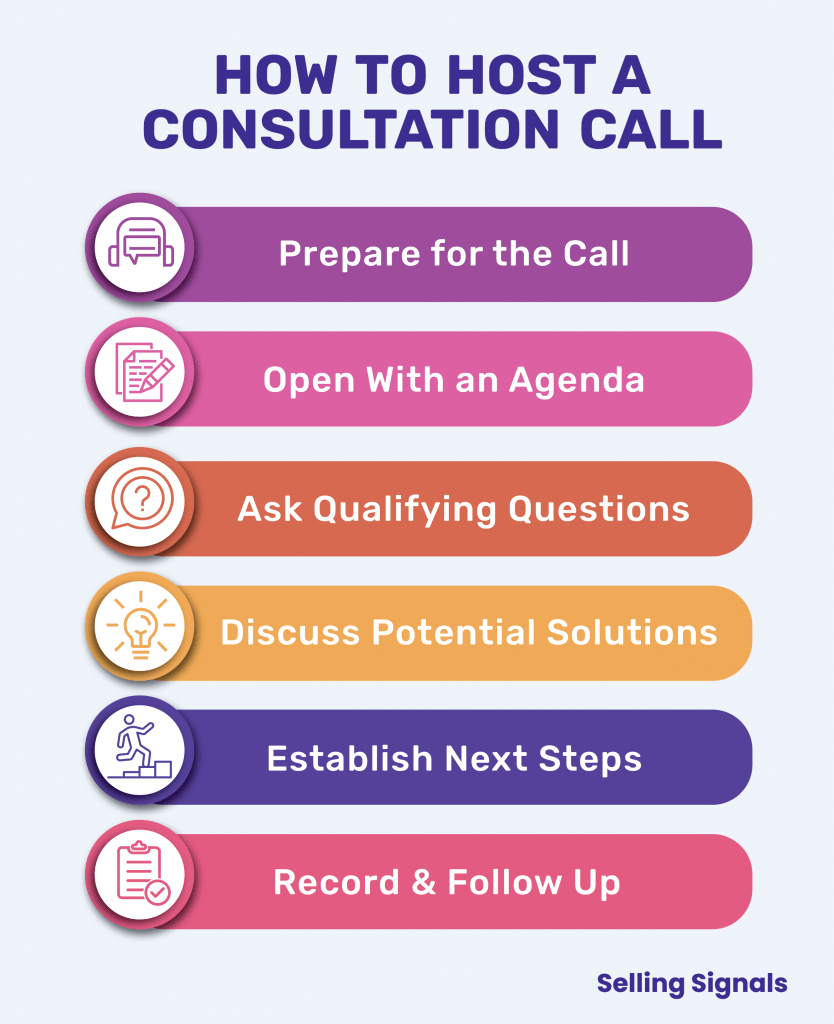-
News & Trends -
Sales -
Marketing Related Topics -
B2B Software Guides Related Topics -
Free Tools & Resources -
- About Us About Us


A consultation call is a brief conversation between a salesperson and a lead with the purpose of finding a tailored solution to the lead's needs. Typically, a potential customer books a consultation call directly on your website using a client intake form. During the call, you qualify them as a fit, discover together how you can best help them, and decide whether they should move forward in your sales pipeline or even close the deal the same day.
Salespeople offer consultation calls to provide insight into their sales process while prioritizing their lead’s goals or pain points. Businesses typically host a client intake form on their website or landing page for leads to submit information like their contact info, their need, and the services they’re looking for. Detailed forms gather key information to supplement a seller's pre-call research — this helps you start to qualify the lead to ensure they could be a good fit, plus prepare for the call.
Typically, consultation calls will preface any official meeting with a lead. This call can be part of the discovery call and sales call process, or in lieu of either or both. Ultimately, consultation calls are centered around a discussion rather than a sales pitch for a certain product or service. The majority of the call involves hearing your lead out and talking over possible solutions to their problem.

A sales consultation call should last around 15–20 minutes. You can choose to charge a fee for them, but a large appeal of free consultation calls is that the lead can get quick professional guidance at no cost or commitment. As a subject matter expert, you can lend your market knowledge as needed, then suggest the appropriate next steps in your sales process.
Your goal at the end of a consultation call is to have a better understanding of the lead’s need and how you can potentially add value. This call is ultimately a sales tool and, if utilized correctly, will create an atmosphere that promotes genuine relationships. As you think about how best to hold this call for your business, it's key to learn the steps plus read examples and tips from sales experts.
Consultation calls facilitate relationship building, so they're best for businesses that sell products or services involving frequent interaction with customers. These calls also work well for companies that offer tailored solutions rather than a set product or package. Finally, they can be a great marketing tactic for sellers trying to bring more leads into their pipeline.
Specifically, here’s who should consider hosting consultation calls:
These calls build confidence that the partnership is a right fit for you and your clients, which can equate to both securing and retaining deals.
Consultation calls can be great first contacts to explore potential solutions at a high level and how you can customize your product or service for leads.
When servicing a new territory, advertising free 15- to 20-minute consultation calls can help attract new customers and referrals.
If you’re looking to qualify a lead in depth before selling to them or they’re already highly qualified and you’re ready to pitch a certain product or service, consider holding a formal discovery call or sales call, respectively. Also consider if offering consultation calls realistically fits within your current bandwidth — can you afford having salespeople allocate their time to these services? If so, a consultation call might be the best route for you.
To see success in consultation calls, first pre-qualify your lead and prepare as much as possible going into the call. Then set the tone by introducing yourself and the agenda. Even though you’ll be giving the lead time to talk through their problem, drive the conversation to identify the need and collaboratively find solutions. Based on the conversation, suggest the appropriate next steps, then record the conversation and follow up with your lead.
Most consultation calls will come from lead capture software on your website or landing page, so it’s important to pre-qualify the lead and ensure they could be a fit to protect your time and theirs. Review their online form answers and then write additional questions about their company, pain points, goals, and the solution or product they’re looking for. Also do independent research on the lead and their company to learn more about them prior to the call.
Below are four points you should have a solid understanding of before the call:
Take a moment to write down these answers to use as a reference tool on the call. Since the call will be so brief, having this information handy will help the conversation to stay centralized and productive. If there are any gaps in information, don’t hesitate to reach out to the lead explaining you need more detail in preparation for the scheduled call, or suggest another company if the lead indicated in the form that they want something you can’t provide.
One of the benefits of holding a consultation call is its emphasis on relationship building. Introduce yourself and your company here. Welcome brief small talk to build rapport, then remind your prospect of the time restraint and present your agenda and goals for the call. Rely on your skills as a salesperson to transition the conversation from personal to business as smoothly as possible.
Here's a closer look at each component of this step:
There’s a lot to discuss in only 15–20 minutes, so keeping this part of the call to about three minutes allows more time for the lead to explain their need. Politely make sure they know that there’s a set time limit for this call, as well.
While you may already have an idea of why your prospect is interested in a consultation call with you, this call allows you to flesh out their need more in depth than a written form. From your research during preparation for the call, you’ll know what information you’re missing. Without turning the conversation into an interrogation, ask questions that fill these gaps.
Here are questions you should consider asking to gather key details:
This part of the call should last 5–10 minutes. By practicing active listening, you’ll demonstrate to your prospect that your goal is to help them conceptualize a solution, not just to close a deal.
After giving the prospect the floor, begin discussing an ideal solution. This is where your professional experience will drive the conversation. Here you’ll discuss your products or services where applicable. You’ll have the anticipated solution from the research phase, but there will be scenarios where you’ll have to come up with a custom solution or idea on the spot based on your conversation with the lead. Together, decide what would best fit the lead and solve their pain points.
If the lead seems hesitant about a proposed solution or expresses apprehension in general, utilize objection handling to strategically respond to their concerns with empathy and expertise. Since consultation calls are so dependent on relationship building, aim to get to the root of the concern and move on once your lead is satisfied. This solutions step should ideally last around five minutes.
Depending on the solution you and the prospect come to, be prepared to quickly run through your own sales process and what your prospect can expect next. You can pull from your sales pitch or elevator pitch script here to sell why your lead should continue working with you.
Natural next steps to nurture your prospect might include activities such as:
Since the majority of the consultation call will be a collaboration between you and your prospect, make sure you allocate 2–3 minutes toward the end to chat through any other key details about your product or service, plus next steps. Details around your solution and future steps will likely bleed into the next meeting as well. Proactively schedule the meeting and give the prospect insight into what you may ask of them moving forward.
Once you connect via a consultation call and you mutually agree to progress forward in your process, record your notes from the call in your CRM software and initiate follow-up quickly after. Time is of the essence here since you know your prospect is actively in the market for a product or service similar to yours.
Here's how to follow up after a consultation call with a good- or bad-fit lead:
Following this guide to hosting a consultation call can help you have a productive and successful first contact. Remember to adjust and customize this outline as needed while maintaining the emphasis on partnership building and collaborative solutions.
To help you understand how a consultation call can progress, below is a brief example of a call between you as the salesperson and a lead who has requested a call with you. In this scenario, your lead has submitted an online form through your website because they're interested in the landscaping services you offer. Take note of the brief introduction and small talk, collaborative discussion, and then appropriate next steps offered.
Click the below to expand and read the example:
You: “Hi Matt, I’m Michelle. I’m a representative with Jones Landscaping. How are you this Friday morning?”
Lead: “Hey Michelle. I’m doing well, thanks for asking! Happy it’s Friday.”
You: “I totally get it. Do you have any special plans for the weekend?”
Lead: “I’ll be traveling into the city for the basketball game Saturday. I’m a big Wolves fan.”
You: “Oh, that will be a great game. Your new head coach seems to be doing well with the team!”
Lead: “Exactly. I’m looking forward to it.”
You: “I’m sure you’ll have a blast. But thank you so much for being flexible scheduling this call. I’m excited to walk through what you’re looking for and how we could help. How our consultation calls usually go is for the next 5–10 minutes I open the floor for you to describe what you’re looking for, and I can suggest how we can help to get you the result you ultimately want. Then we can set up the next steps as necessary and wrap up for the last two or so minutes.”
Lead: “Of course. Thank you for getting back to me so quickly.”
You: “Absolutely. So, I’ve reviewed the inquiry you submitted through our website and I understand you’re looking for a design and installation of a landscape for a property that’s about 8,000 square feet. Do you mind just explaining that a little further?”
Lead: “My company recently moved into a new and larger building closer to the city, and we need the front and side landscape to be fixed up for cosmetic and logistic purposes. It’s currently all gravel. I specifically like the job you all did with the dealership that’s posted on your website.”
You: “First off, congratulations on the move! You’re a durable medical equipment company, correct? Knowing that helps us understand your needs even further.”
Lead: “Yes, we’re a DME company. We supply medical equipment like high-powered wheelchairs and specialty beds to patients.”
You: “Working with DME, I suspect you need the landscape to be accessible also?”
Lead: “Yes, exactly! So there’s a sense of urgency around getting this completed for us to be fully operational for clients to visit.”
You: “I totally understand, especially considering all you have is gravel currently. I’m glad to hear you like the landscape of the dealership project. I imagine we can do something very similar. I also checked out the address of your property you submitted on our form. I searched it on Google Maps and saw vines on the building. Are they still there?”
Lead: “Yes they are. The whole property is in pretty poor shape currently.”
You: “That is totally fine. I would suggest we widen the dimensions of the walkways and switch the vines to greenery to prevent hazardous overgrowth and account for wheelchairs and walkers. That job requires regular maintenance that we provide; is that something you would have room in your budget to consider?”
Lead: “Yeah, we would ideally have you contracted out to maintain the property if that’s something you offer. That could include repairs and regular maintenance like grass cutting and hedge trimming, correct?”
You: “Yes! So, projects of this scale, from concept to installation, usually take between 6–10 weeks. And we send out a maintenance crew every three weeks, depending.”
Lead: “That sounds reasonable. We’re still working out of our current location until the end of next month, so that schedules well.”
You: “Oh good! So, next steps from here are this: I want to schedule getting our lead architect and me out to the property with you to start conceptualizing what you would want and where. I’ll send you a follow-up email now with a summary of this conversation and our Calendly link for you to pick a time when you’re available. From that meeting, we’ll create a render with a set quote for you to look over and approve. Once we get our contract signed, we can get this started for you!”
Lead: “That’s perfect. Thank you for taking the time to talk through this with me. I’ll reply back with my availability ASAP.”
You: “Great! Talk soon.”
In this example, you as the seller fleshed out your lead’s needs at a high level during a brief first call. You demonstrated active listening and found out the lead has an allocated budget, a timeline to get the service completed, and a plan to be a user of your service long term. This, and your ability to share knowledge and suggestions, should leave you and your lead confident about moving forward in your sales process.
When conducting a sales consultation call, there are certain tips and tricks to ensure you connect and add value to your lead within the limited time available. Incorporating research and pre-qualification, driving collaborative conversations that focus on the lead’s pain points, and streamlining follow-up are all ways to ensure a rewarding call. Below, you can read what our sales experts have to say about navigating a successful consultation call.


Co-Founder
“Doing your homework about the prospect is the best way to approach a consultation call. The more you know about the person you’re speaking with, the better prepared you’ll be to address any questions they may have. After all, you are trying to win their business, so you need to be informed. If you sound uncertain of yourself, how can you expect them to start working with you?”
— Bridget Reed, The Word Counter


Managing Director
“It’s easy to slip into the trap of converting your consultation into a presentation when you are self-assured about your services and proud of what you have to offer. In this scenario, the consumer sits passively in the audience while you provide the information. You should frame the consultation as a discussion and make an effort to create a relationship with the client through the course of the session.”
— Tom Hamilton-Stubber, TutorCruncher


Owner
“When I coach sales teams, my biggest piece of advice for consultation calls is to focus on the prospect's needs, not the product's benefits. If the prospect asks a question about their needs or pain points, dig into the reason they asked instead of launching straight into a canned answer.”
— Dan Gower, Buddy Gardner Advertising


Managing Director
“The professional is you. Our responsibility is to offer answers. Don't be afraid to gently tell the client if they ask for something that you think is a bad idea. Inform them of the factors, the reasons it would fail, and the alternative you would recommend. They will be appreciative of your sharing your knowledge and preventing them from making a mistake.”
— Alex Armstrong-Paling, Toolfit


Director
“Send a follow-up email within 24 hours after the consultation call. A lot of information gets easily lost when conveyed verbally, so a black-and-white reference is a must. The email should be highly personalized and convey gratitude for your prospect’s time so far. Beyond addressing your potential client by name, refer to info exchanged during the call and establish in writing their pain points and the solutions you can offer. Show passion and enthusiasm at the prospect of working together. Propose next steps or a next point of contact and always offer a two-way method of communication so they can reach out.”
— Eric Ang, One Search Pro
Taking these tips into account will ensure constructive and valuable sales consultation calls. As you develop your own consultation call process, you’ll also conceive your own best practices.
There are benefits to charging for a consultation call or offering a free one. Applying a fee to consultation calls ensures your lead is serious about learning more about your product or service. But allocating time, free of charge, to cater to inbound queries from prospective clients establishes a strong sense of trust and partnership early on in the pipeline, which is often invaluable. Free consultation calls tend to work best for most businesses.
Hosting discovery and sales calls is one path to follow in the sales process, while consultation calls typically can stand alone. Discovery calls and the use of frameworks generally aid in the heavy qualification of leads, then sales calls usually lean on pitching your product or service. Consultation calls are conversations that focus on a collaborative solution rather than immediately pitching a service or product to the lead.
Once you determine if offering consultation calls works in your sales process, they can prove to be extremely handy in relationship building with your lead. These calls present you as a true subject matter expert of your field who offers knowledge-based solutions directly to prospective customers. A successful sales consultation call allows for a smooth transition from lead generation and qualification into lead nurturing and then closing those deals.


Allyssa is a sales writer with a background in B2B sales and account management. After earning her degree in English and communications, she spent her selling career supporting Fortune 1000 IT and finance companies including Bank of America, Wells Fargo, and Credit Karma. As a staff writer for Selling Signals, her specialties include lead nurturing, lead generation, and sales software topics. When she's not writing or updating articles, you can find Allyssa writing poetry, traveling, or picking up any new creative hobby.

Selling Signals delivers actionable advice for sales and marketing professionals. Learn strategies that help you hit targets, strengthen customer relationships, and win more business. Get expert advice on lead generation, sales processes, CRM software, sales management, and account management directly to your inbox.
Property of TechnologyAdvice. © 2025 TechnologyAdvice. All Rights Reserved
Advertiser Disclosure: Some of the products that appear on this site are from companies from which TechnologyAdvice receives compensation. This compensation may impact how and where products appear on this site including, for example, the order in which they appear. TechnologyAdvice does not include all companies or all types of products available in the marketplace.